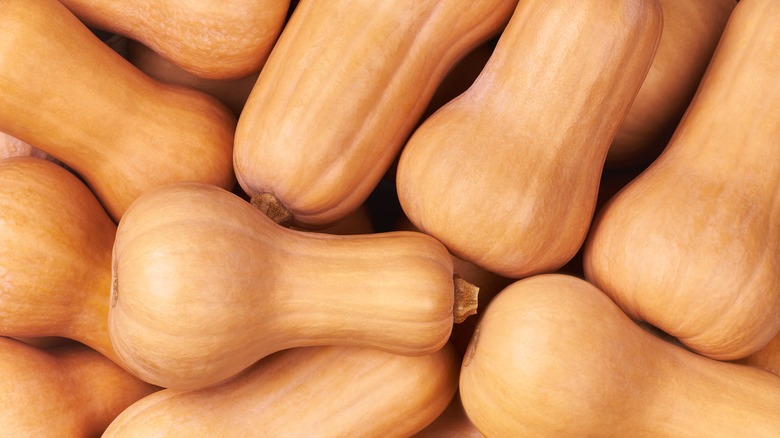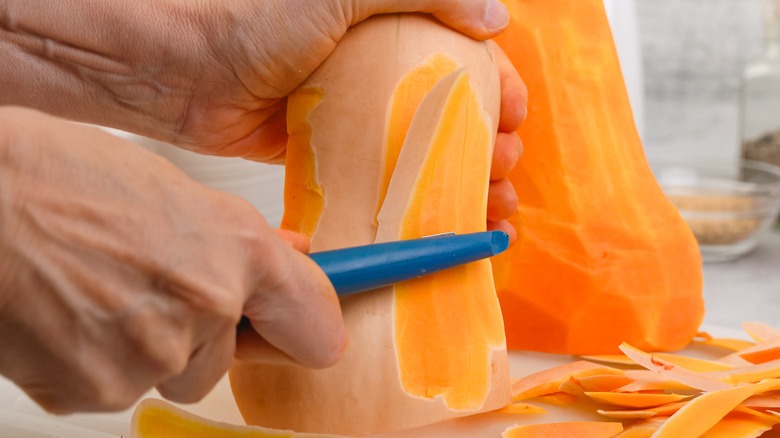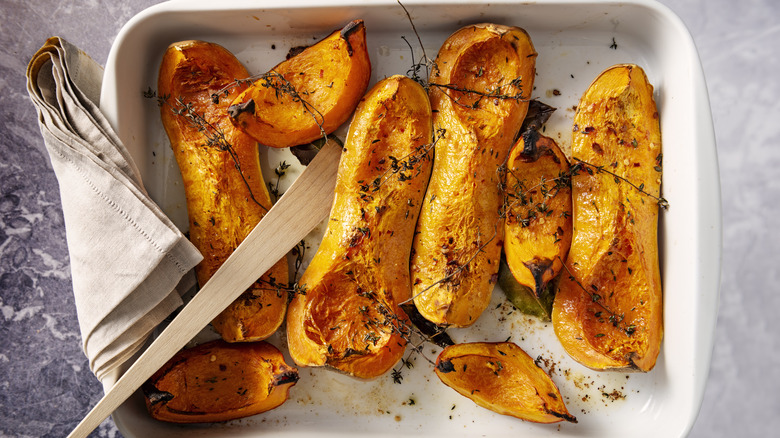The Peeling Tip For The Most Tender Butternut Squash
There are numerous hacks out there that'll have you cutting the thickest veggies with ease. Nevertheless, peeling a butternut squash can be a daunting prospect. You've sharpened your knife and cleaved off the base to keep it stable as you work, but still, the thought of paring away the tough skin is an ominous proposition. No matter how carefully you trim, strip, and shave that stubborn outer layer, even the simplest roasted butternut squash returns from the oven with tough edges. Well, it's probably because you haven't peeled your squash enough.
As you scrape away the hard skin of your squash, you will notice that the surface of its flesh has a whiteish hue. Of course, we all know butternut squash to be a vibrant orange, which is what you need to aim for as you strip the rind away. So, keep shaving until you reach the deeper color you're looking for. You should expect to take off around ⅛ inch of excess woody skin to get to the juicy flesh that will roast to tender perfection. There is, however, a way you can make squash peeling easier.
Foolproof hacks for peeling butternut squash
If you regularly cook with winter squashes, you might already be familiar with the microwave hack that makes cutting them easier. Well, the same goes for peeling them. If you top and tail your butternut squash, use a fork to pierce the skin all over, and zap it in on the highest setting for three minutes, the flesh will be soft enough to make stripping the rind away a breeze. Just remember to wait for it to cool a little after removing it from the microwave. Alternatively, you could skip this step entirely. Some argue whether it's necessary to remove the skin at all.
As it happens, almost every part of butternut squash is edible. Yes, including the tough skin. British celebrity chef Jamie Oliver advocates eating every part of the veg. "You can eat the skin," he says on his website. "So there's no need to peel it. Simply halve it, scoop out the seeds, and chop it into chunks, then roast it and add it to a warm winter salad or throw it into curries, stews, or soups." Roasting the seeds is, of course, a delicious alternative to throwing them out. They can be eaten as a snack or used for added crunch as a salad topping. Eating the skin, however, is open to debate.
Edible doesn't necessarily mean tasty
Squash skin is perfectly safe to eat, so is deemed "edible." Its texture, however, although softer than when raw, will still be difficult to chew. There's a seasonal difference to remember when deciding whether to peel your squash or not: Summer squash, like zucchini or yellow squash, has softer skin. Winter squash, like pumpkin or butternut squash, is much thicker and harder. So, you're probably better off peeling a butternut squash after all.
One thing about thicker skin is it gives squash a clear advantage over other veg by offering a more robust protective shell. That means a longer shelf life. If you observe the best way to store butternut squash, it can last for several months before you think about using it. That's assuming the skin is still intact. However long you leave it, just remember to remove all the pale rind when you peel it and your squash will emerge tender from the oven every time.


